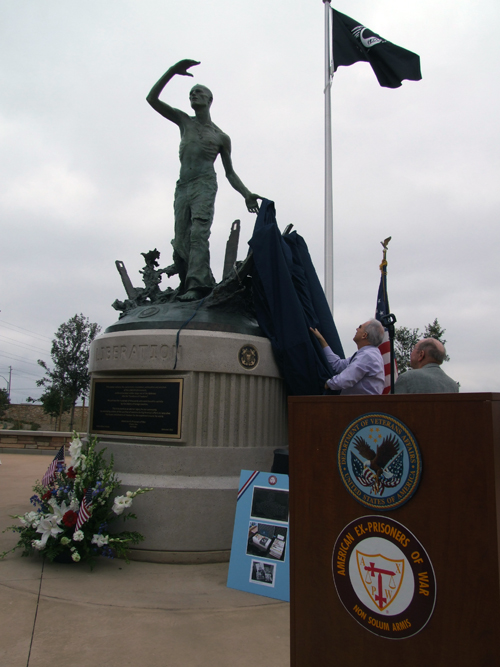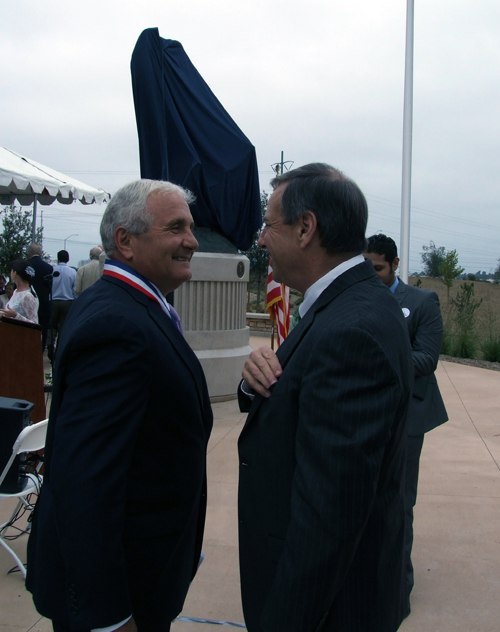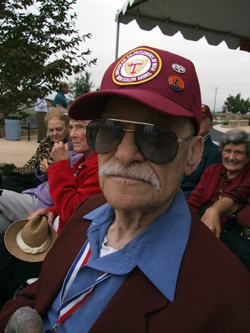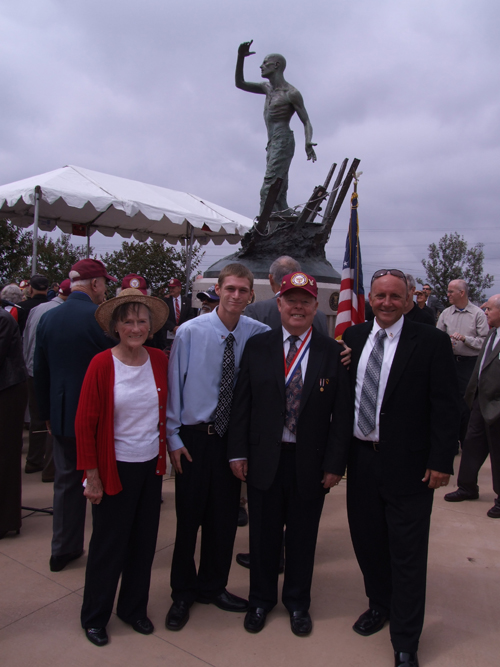
By Donald H. Harrison
SAN DIEGO—The first monument at the Miramar National Cemetery, which one day will be the final resting place for nearly a quarter million veterans, was dedicated on Friday, Sept. 16, in honor of American Ex-Prisoners of War. Unveiled was a 15-foot-tall, seven-ton-statue, named “The Liberation Moment,” sculpted by Richard Becker of Poway.
On hand to watch the unveiling was Anthony Principi, the former U.S. Secretary of Veteran Affairs in George W. Bush’s administration, who said the statue depicts “the happiness of a hero who has finally broken free of the barbed wire boundaries that had kept him in prison. “ But viewers who gaze at the statue “will also see in the hero’s emaciated body and ratted clothing, the hunger and deprivation prisoners of war have endured throughout our history simply for defending freedom for all Americans. In the hero’s haunted gaze, we feel both his joy at being liberated and his sadness that some of those with whom he shared this captivity did not survive.”

Within the base of the statue is a time capsule to be opened in 2045 – 100 years after the end of World War II. Among DVDs bearing the testimony of ex American prisoners of war, and books that some of them wrote, is one volume by Sy Brenner, 89, who sat in the front row for the outdoor ceremony. His book, The Night I Got Killed, tells of being a Jewish-American soldier who had to hide his religious identity from his Nazi German captors.

Brenner said he remembered the day of his own liberation from a prisoner of war camp near Stuttgart, Germany, “vividly.”
“The guards took off from our prison camp two or three days before the American army came and I was wandering outside of the camp, and some French people told me that the American Army was near the administration building and I went there,” Brenner related.
“And I saw the Nazi swastika flag coming down and the American flag going up, and they started playing ‘The Star Spangled Banner,’ and I started crying. In fact I was crying so hard my whole body was shaking. And I was thinking of my parents and wishing they were there to see that Nazi flag come down, and that everyone in the United States should see it come down.”
For Thomas Crosby, junior commander of the San Diego Chapter of the American Ex Prisoners of War, Liberation Day came across the world at a Japanese-run POW camp in the Philippines. His father, a General Electric employee, had been visiting headquarters in the United States when 8-year Crosby, his mother, sister and grandmother were all captured by the Japanese, and separated for three years – with girls and women in one area of the camp, men in another and boys in a third. There were 3,500 prisoners in all, 220 in the building where Crosby was kept prisoner.
“February 3rd, 1945, the day of liberation, the 1st Cav (1st Cavalry Division, an armored unit of the U.S. Army) spearheaded 100 miles down to rescue us, and the Japanese held us , 220 of us, hostage, and shot it out with the 1st Cav – 65 of them,” Crosby recalled. “Thirty-six hours later, after the shootout, we thought we were gone. Col Hiyashi wanted to trade us, the 220 of us, for their escort out to their front lines. They couldn’t do that right away because the 1st Cav. didn’t have their reinforcements. When they did, they did what they said they were going to do – they marched them out. When they marched them out, we were free!”
Free, but far from healthy. Crosby said although he was 11 years old at the time of his liberation, he weighed only 48 pounds. He said among the adults weight losses of 50 to 60 pounds from malnutrition were not uncommon.
Crosby’s 18-year-old grandson, Tommy, is of slender build. Three years ago he modeled over several sessions for sculptor Becker, at one occasion holding the pose for the statue for nearly an hour. Watching the unveiling of the statue with his image portraying the agony and exhilaration of his grandfather, was a “great honor for me,” Tommy Crosby said. “Everyone here who is an ex-POW has been through so much; this was an opportunity to be able to give back to them…. “

His girlfriend, Kari Hardisty of El Cajon, standing by him, told her reaction: “I was very proud. It’s very exciting.”
And his grandmother, Nancy Crosby, commented: “Today was really meaningful: I am fighting tears back. The meaning of this statue is so personal, and yet so personal for everyone here.”
Grandpa Thomas, Father Thomas Jr., and Tommy Crosby have a proud family tradition. “All of us our adopted!” said the senior Crosby, whose special project was the time capsule.
With the time capsule scheduled to be opened 34 years from now – and grandchildren and great-grandchildren being asked to attend that ceremony – Crosby said he wondered how technology might change by 2045. Will they even be able to play the DVDs? He said he included a DVD player in the capsule, just to make sure that they could.
Steve Muro, undersecretary for Veteran Affairs in the Obama administration, said the Liberation Moment memorial, which has a POW/MIA flag flying near it, brought to mind for him a memorial he once saw in the Himalaya Mountains honoring the war dead of many nations. A legend on that monument read: “Tell them we gave our tomorrows, so you can have your todays.”
*
Harrison is editor of San Diego Jewish World. He may be contacted at donald.harrison@sdjewishworld.com